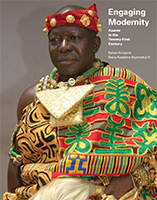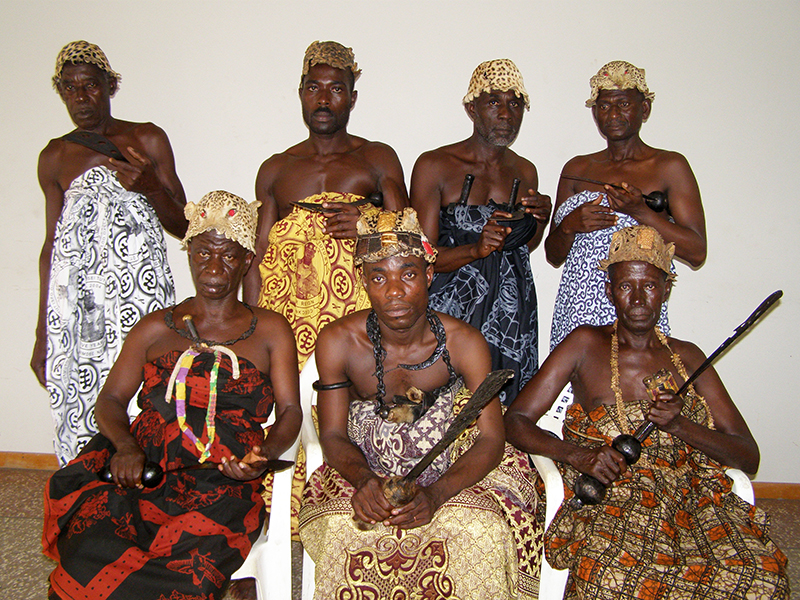
Engaging Modernity: Asante in the Twenty-First Century
Skip other details (including permanent urls, DOI, citation information): This work is licensed under a Creative Commons Attribution-NonCommercial-NoDerivatives 3.0 License. Please contact [email protected] to use this work in a way not covered by the license.
For more information, read Michigan Publishing's access and usage policy.
Abrafoɔ (Executioners/Constabulary)
Like the modern day armed services, Abrafoɔ generally refers to those who, in the olden days, constituted the constabulary and were responsible for law enforcement in the kingdom. These include Abrafoɔ (executioner and poets), Tɔprɛfoɔ, and Animosum. The Abrafoɔ and Tɔprɛfoɔ were, in the past, responsible for carrying out executions and other forms of punishment for criminal offenders and in some cases, war captives. In current terminology, we may consider the animosum (also known as anadwosekan or night knife in English) as commandos or more accurately, special forces. While it is the duty of Asekanfo (lit. knife bearers) to protect the Asantehemaa, they are not, technically speaking, regarded as Abrafoɔ. The Asekanfo are from the area in downtown Kumase called Adum which is a corruption of Anum the Guan town in southeastern Ghana. The Adumfoɔ (Anumfoɔ) were special men who were assigned to protect and guard Ɔpemsoɔ Osei Tutu on his way from Akwamu to Kumase to be enstooled as Chief of Kumase. The Abrafoɔ, Tɔprɛfoɔ, and Animosum however perform a variety of duties related to the Asantehene or Asikadwa Kofi depending on the ceremony and it is fair to say that they are associated with the Asantehene.
The first group, Abrafoɔ are those who recite apae (appellations poetry) when Otumfoɔ sits in state, or during purification rites in the nkonwafieso (stool room) when the black stools of past kings are brought out, or when sikadwa is in a procession or during funerary rites. There are four independent groups with their respective chiefs. The chiefs are Baafoɔ Asuman Kofi Ababio (Nkram Abrafoɔhene), Baafoɔ Kwaku Antwi Baah II (at the time, Anoo Abrafoɔhene), Baafoɔ Kwadwo Kuma (Boamang Abrafoɔhene), and the Tweneduroase Abrafoɔhene who was not available. Although all the above-named chiefs are leaders in their own right, as a group, the Nkram Abrafoɔhene is the overall Abrafoɔhene (Chief of Abrafoɔ).

Seated from left to right: Baafoɔ Kwadwo Kuma (Boamang Abrafoɔhene), Baafoɔ Kofi Antwi Baah (Anoo Abrafoɔ), Baafoɔ Asumang Kofi Ababio (Abrafoɔhene/Nkram Abrafoɔ, Abrepɔkese)
Standing from Left to right: Kwabena Kyeremeh, Kwabena Poku, Akwasi Amankwaa, Kwame Osei Tutu
Description of dress:
The combination of print cloth and a leopard’s hat as a dress began in recent momory and can be dated from early in the twentieth century when print cloths were introduced to the Asante Kingdom. The main dress of the Abrafoɔ was made entirely of the leopard’s skin that they wrap around their body and a leopard hat known as etwiekyɛ (leopard’s hat). Some of the hats have two eyes painted red on the forehead while others, especially the individual chiefs, have the leopard’s ear with sika nsɛbɛ (gold talismans) and leather talismans fixed on it.
Necklaces:
All the chiefs have some type of necklace. For instance, Nkram Abrafoɔ’s necklace is nipa akyi nkasɛe (dry bones of a spinal chord). The two necklaces worn by the Anoo Abrafoɔhene are dadie kɔnsɔnkɔnsɔn (metal chain) and nkɔnsɔn dadeɛ. The former is originally made of pure gold that replaced sɛpɔhoma (made from a vine). Due to its weight, it was used as a weapon in the past by striking the head of an enemy with it. On the other hand, the nkɔnsɔn was used as a grip around the throat to prevent a condemned person from cursing the executioners. For Tweneduroase Abrafoɔhene, his necklace is made of kɔɔbre (copper). It is notewhorthy that all the swords and necklaces of Abrafoɔ are black due to contact with human blood in the past several centuries.
Swords:
Unlike kɛtɛanomfena, abrafoɔ swords do not have abɔsodeɛ and as a result, they hold the hilt while the sword blades are not in sheaths but exposed. The Nkram Abrafoɔhene’s sword is called kontonkronwi (refers to the hair around the neck). The Akan saying is that death is like the hair around the human neck, we all have it. That is, we shall all succumb to death one day. Anoo Abrafoɔhene’s sword is called, gye me di (trust me). Additionally, they all carry sɛpɔ (knives) in bɔha (leather sheaths) that they keep in the cloth but close to the chest. The four sɛpɔ knives on the Nkram Abrafoɔhene have unique names: kumamani (lit. killer of known persons/townsmen), kumahɔhoɔ (killer of visitors), kumadehyeɛ (killer of royals), and sɛpɔ (knife).
Format of reciting apae:
As stated above, this group of Abrafoɔ have an additional and a special duty of reciting horoic poetry, Apae. Although it is generally regarded as mmrane (praise poetry), Apae engages historical narratives by recounting past wars while the mpebi ne nkrawiri drums punctuate the cadences or sometimes overlap the voice. When the Asantehene sits in state either for a celebration, a funeral, or during the Akwasidae, the four chiefs will first take turns to recite apae and then step back to allow their children to also take turns to recite. When reciting, they lift the sword in the right hand, make a fist with the left hand and place the fisted left hand on the back of the sword, and while facing the Asantehene, they recite apae. Reciting apae is random and depends on how the spirit moves the Abrafoɔ to the extent that sometimes one person can recite two or even three apae back to back before yielding to the next person in line. While their children are reciting, all four chiefs will be on their feet and ready to step... in the likelihood that they blank out or forget a line. When that happens, that particular child will fall back immediately to regain his composure before rejoining the Abrafoɔ.
Baafoɔ Asuman Kofi Ababio Abrafoɔhene
Nkram Abrafoɔ, Abrepɔkese
The Nkram Abrafoɔ group came to Kumase from Adanse Nyaadoam which was part of Denkyira at the time. Asantehene Opoku Ware created the Nkram Abrafoɔ stool together with the kontonkronwi sword when they were formally presented to him. The king realized that they were brave and fearless men who would not waver or fumble if asked to execute criminals. The primary duty with the sword was to guide Opoku Ware’s wife who lived at the time in Abrepokese. Additional duties included the regular som (service) during the day in the king’s palace where he was assigned the role of taking criminals to Nkram. He sits to the left when the Asantehene sits in state while he together with the other three Abrofoɔ chiefs walk ahead of the kɛtɛanomfena in a procession. Similarly, he places his sword on the left hand side of Asantehene when he is carried in a palanguin and it is his sword, kontonkronwi, that absorbs and deflects bad spirits from the Asantehene.
Kwaku Antwi Baah
Anoo Abrafoɔ
Nana Brafonyam was part of the retinue of excecutioners who guarded Ɔpemsoɔ Osei Tutu from Akwamu to Kumase. Kɔmfo Anɔkye later created a special sword for Nana Brafonyam to guard the Gold Stool. Anoo covers present-day prisons, the Highcourt, the soldier line to Kɔmfo Anɔkye Hospital roundabout. Later King Opoku Ware relocated the Anoo Abrafoɔ to Ahodwo Mmaakro for them to protect his wife. Mmaa describes the sticks the Anoo Abrafoɔ used to whip trespassers who, for some reason, were caught hanging around the area where the king’s wife lives.
Baafoɔ Kwadwo Kuma
Boamang Abrafoɔhene
Asantehene Osei Kwadwo (Ɔko Awia) created this stool and like others, his primary responsibility was to guide the King’s wife in the night at Boamang and serve in the palace during the day performing similar duties as described above. Initially, the king asked the Amoakohene to settle this group on his land but when the latter realized that he had no land available, he suggested Boamanhene. Since his wife was living in Boamang, he gave them the Abrafoɔ sword and charged them with guarding his wife in the night and, as in all the above cases, performing his duties in the day in the palace.
Twenuroase Abrafoɔhene
Since he was not available at the time, a member of this group, Kwabena Akyeremeh, spoke on his behalf. This group came from Denkyira Amantuom, settled in Dwaben and from there, relocated to Efidwaase Ntumkumso. It was here that the Atano appeared in the family and when they presented it to the king and he asked about its mission, the Atano responded by saying, “I am abrani (singular, executioner) and I am here to serve you in that capacity.” Upon hearing that, the king placed them with Asuman Kofi, Nkram Abrafoɔhene, and the Atano became the main diety of this Abrafoɔ group to this day. Atano are fundamentally different from Abosom.Abosom are acquired or created by individuals but Atano practically appear from the sky or the spirit world on their own without human intervention. Abosom is the result of individuals going to acquire nsuman (spirits) from near or far lands. The Atano is really strict in terms of what its needs are and they are probably not appearing like they used to in the past due to all the social evils in Akanland today. Since they appeared by themselves, they usually will inform you, through a human medium, who they are, what they do, what they like and what they dislike. They were either placed in yaawa (a basin), ayewa mu (earthenware basin), or kuduom (a casket) depending on their preference.


